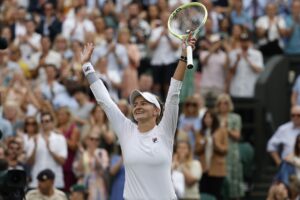A lost generation
I’ve watched tennis for decades, and enjoyed the variety of champions over the years such as Bjorn Borg, Rod Laver, John Newcombe, John McEnroe, Jimmy Connors, and so many others. Currently tennis remains under the thumb of the so-called Big Three – Roger Federer, Rafael Nadal and Novak Djokovic.
In the past ten years or so, a crop of players emerged– spearheaded by the likes of Grigor Dimitrov, Milos Raonic and Kei Nishikori. All have had some fine results, with both Raonic and Nishikori reaching Grand Slam finals. But none of them were able to decisively break the dominance of the Big Three. Nor were the slightly older crop that included Jo-Wilfried Tsonga, Tomas Berdych and David Ferrer, although both Marin Cilic and Stan Wawrinka did win Majors. Many have termed them a ‘lost generation’, whose careers stalled in the face of the Federer, Nadal and Djokovic’s dominance.
The new generation
Now, another cadre of players have arrived to offer their challenge to the sport’s established icons, amongst them Alexander Zverev, Borna Coric, Felix Auger-Aliassime, Dominic Thiem, Denis Shapovalov, Stefanos Tsitsipas and Daniil Medvedev. Many believe that they could be the group to finally upend the Big Three. But is that realistic?
The recent roll of honour at the Grand Slams is dominated by three names. For example, outside of the Big Three, only one player has won Wimbledon in the past sixteen years and that was Andy Murray, who claimed titles in 2013 and 2016. The US Open has offered slightly more variety, but still Federer, Nadal and Djokovic have accounted for 11 of the past 17 titles. At the Australian Open, they’ve won 14 of the past 18 titles and at Roland Garros they have claimed 13 of the last 14 titles, with Nadal having won 11 by himself.
Why the domination?
The likely reason for their dominance is both physical and emotional. Modern medicine and rehabilitation techniques are enabling them to recover from what would have been career-ending injuries in previous eras. Emotionally, they are tough and confident. When you’ve won 20 Grand Slam titles as Federer has, it surely breeds an almost unassailable confidence. Indeed, so dominant have the Big Three been, that of the past 62 Grand Slam events, they have won 51.
What can tennis do?
The sad reality is – nothing. Tennis is stuck in a rut with three men dominating the sport. Until they retire, this will continue. They earn millions of dollars from tournaments, endorsements and appearance fees, all whilst further embellishing their legacies. Who would quit under such circumstances? Their bodies may be ageing, but they all have physiotherapists travelling with them. And most importantly of all, all three men devote themselves entirely to winning.
The NextGen
Many fans place their hopes on the new crop of players. Of those, only two have so far claimed wins against every member of the Big Three – Tsitsipas and Thiem. Shapovalov has beaten Nadal and Coric has defeated Federer. The rest have yet to show their mettle against the very best in the sport. They have all, however, won titles except Shapovalov and Auger-Aliassime, although Auger-Aliassime has reached two finals, most recently at the Lyon Open. Thiem arguably appears the player most likely to break the domination, particularly on the clay where he can be so devastatingly effective. The ice-cold Tsitsipas is perhaps a close second, especially as a result of his quality across all three surfaces.
Tennis in the moment
But the continued dominance of these three men looks set to continue until someone can truly stand up to them. When they can no longer win titles, they will retire. There is, of course, a psychological side to all of this. Young players who see Federer, Djokovic, or Nadal on the other side of the net are understandably intimidated. In a match where they would normally perform well, they have more than once crumbled under the pressure.
The young players need to learn something crucial about professional sports. It’s about developing a mental toughness that powers you through the difficult matches. It’s about learning how to be adaptive on the court; change your strategies when Plan A isn’t working. It’s about working with a top-level coach who knows how to win at the top. It’s about hard work day in and day out and making changes to your game to ensure you keep growing and developing. It’s about being fearless on the court and refusing to be intimidated by three men who are coming to the end of their prime and taking it to them in a big way.
A legacy of greatness?
Former-world #1 Andy Roddick once said that “time is undefeated and these guys are doing a hell of a job of fighting it off, but it has to come at some point. Once these guys are gone, there’s a serious vacuum. … Roger, Rafa and Novak — they’re arguably the three best of all time.”





